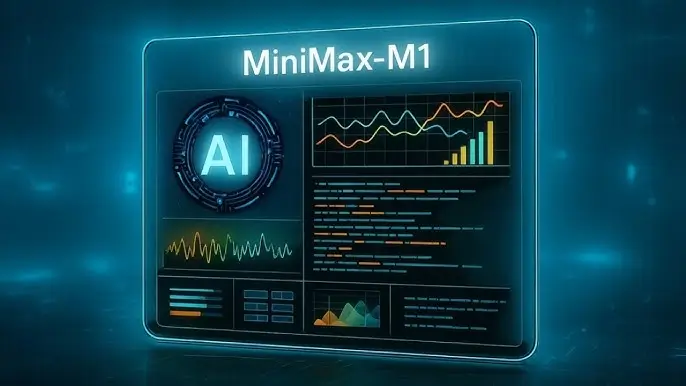China’s AI race has entered a new phase—and the open-source MiniMax-M1 is leading the charge. With its mind-blowing hybrid architecture and record-breaking context window, MiniMax-M1 is positioning itself as a serious challenger to proprietary giants like OpenAI’s GPT-4, Anthropic’s Claude, and Google’s Gemini.

What Makes MiniMax-M1 Special?
Massive Yet Efficient:
MiniMax-M1 combines a Hybrid Attention mechanism with a Mixture-of-Experts (MoE) design. This gives it a theoretical total of 456 billion parameters, but only around 46 billion are activated per token. This means it delivers big model power with much lower compute demands.
Lightning Attention:
Its unique “Lightning Attention” reduces the computation needed for extremely long input contexts—generating 100,000 tokens requires only 25–30% of the inference compute that DeepSeek-R1 needs.
Unmatched Context Length:
MiniMax-M1 natively supports a 1 million-token context window, allowing it to process entire books, massive legal datasets, or long research pipelines in one go. It can generate up to 80,000 tokens at once, rivaling Google’s Gemini 2.5 Pro.
Smarter Training, Lower Costs
MiniMax didn’t just build big—they built smart. They trained M1 using an innovative Reinforcement Learning (RL) method called CISPO (Clipped Importance Sampling Policy Optimization). This algorithm converges twice as fast as older methods like ByteDance’s DAPO.
Training the model only took 512 NVIDIA H800 GPUs for three weeks, costing about $535,000—a fraction of DeepSeek-R1’s $5–6 million price tag and orders of magnitude cheaper than OpenAI’s rumored $100 million for GPT-4.
How Does MiniMax-M1 Perform?
| Benchmark | MiniMax‑M1‑80K | Highlights |
|---|---|---|
| SWE-bench (software) | 56% | Slightly behind DeepSeek-R1 but leading other open models |
| AIME 2024 (math) | 86% | Top-tier performance for math reasoning |
| OpenAI-MRCR (long-context) | 73.4% | Strong long-context comprehension |
| TAU-bench (tool use) | ~62–63% | Surpasses Gemini 2.5 Pro for agentic tasks |
In short, M1 holds its own against closed-source leaders, especially in long-context and complex reasoning tasks.
Real-World Power
Multimodal Capabilities:
MiniMax-M1 isn’t just text—it can handle images, audio, presentations, and large documents. It’s designed to act like a true AI agent, autonomously scraping the web, clicking through sites, or even building functional apps.
Open & Accessible:
All weights are available under Apache 2.0 on GitHub and Hugging Face. There’s even a free demo for the public and an affordable API for developers and businesses.
The Good & The Bad
Pros:
- Handles ultra-long contexts that leave most other LLMs struggling.
- Cost-effective training and inference.
- Fully open-source—great for research, education, and customization.
Cons:
- Inference can be slow, especially with huge contexts.
- Not always the best for real-time coding compared to proprietary models.
The Bigger Picture
MiniMax, founded in Shanghai in 2021, has grown rapidly with multiple foundational models and consumer apps like Talkie. The company recently filed for a Hong Kong IPO, aiming for a $4 billion-plus valuation—a sign that China’s AI players are ready to compete globally.
MiniMax-M1 isn’t just another AI model—it’s a signal that open-source innovation is catching up with big tech’s black-box giants. With its record-breaking context window, agentic abilities, and transparent open-source ethos, MiniMax-M1 is a compelling choice for developers, researchers, and enterprises who want cutting-edge performance without the proprietary lock-in.









